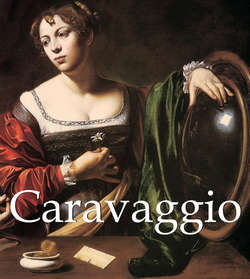Читать книгу Caravaggio - Félix Witting - Страница 2
На сайте Литреса книга снята с продажи.
Biography
ОглавлениеMedusa, 1591–1592.
Oil on canvas mounted on a poplar wood shield, 60 × 55 cm.
Galleria degli Uffizi, Florence.
1571: Birth of Michelangelo, eldest son of Fermo Merisi, foreman, mason, and architect of the Marchese of Caravaggio and of Lucia Aratori, daughter of a well-to-do family, probably from Milan where the Marchese had his court.
1576: The plague arrives in Milan, making the Caravaggio family flee.
1577: Death of his father.
1584–1588: Four year apprenticeship in Simone Peterzano’s studio in Milan.
1592–1593: In Rome, where he works for the famous painter Giuseppe Cesari d’Arpino. The well-known works of this period are Young Boy Peeling Fruit (his first known work), Boy with a Basket of Fruit, and Sick Bacchus.
1594: Leaves Giuseppe Cesari d’Arpino in January. He makes an important friendship with the painter Prospero Orsi who introduces him to some leading collectors. His work The Fortune Teller gives him some recognition and allows him to gain the protection of Cardinal Francesco Maria Del Monte.
1599: Receives the commission to paint the Contarelli chapel in the church of San Luigi dei Francesi. His works are met with immediate success.
1601: A wealthy shopkeeper commissions him to paint The Death of the Virgin for his private chapel in the new church Santa Maria della Scala, of the Carmelite Order in Rome.
1606: The Carmelites refuse The Death of the Virgin. Giulio Mancini, a contemporary of Caravaggio, supposes that Caravaggio chose a courtesan as the model.
During a brawl, Caravaggio accidentally kills the painter Tomassoni. Although under the protection of high dignitaries, he must flee. He goes to Naples where he is out of reach of Roman justice and is protected by the Colonna family. Thanks to the influence of this family, the church awards him the commission to paint the Madonna of the Rosary and the Seven Works of Mercy.
1607: Departs for Malta, to the headquarters of the Knights of the Order of Malta, where he hopes to obtain the protection of Alof de Wignacourt, Grand Master of the Order, and to finally be pardoned.
1608: Wignacourt, impressed by having Caravaggio as official painter of the Order of Malta, bestows on him the Knighthood of the Order. The known works of this period are The Beheading of Saint John the Baptist, the Portrait of Alof de Wignacourt, and some portraits of knights.
He is imprisoned in August after a brawl, during which one of the knights is seriously wounded. In December he is expelled from the Order of Malta.
1609: He spends nine months in Sicily but after getting attacked he returns to Naples to enjoy the protection of the Colonna family, and waits for the papal pardon in order to finally return to Rome. But in Naples, he is once again attacked by strangers. He paints Salome with the Head of John the Baptist, showing his head on a serving plate, and sends it to Wignacourt to implore his forgiveness.
1610: Departs for Rome to obtain his papal pardon. A messenger from Rome informs the court of Urbino about the death of the painter. A poet friend of Caravaggio establishes the date of his death as 18 July.
